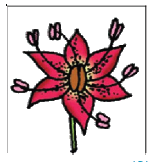To which of the following flower' synandrous' condition is found
Sunflower
Gourd
Pea
Lemon
The correct Answer is:B
To determine which flower exhibits the 'synandrous' condition, we need to understand what synandrous means.
1. Definition of Synandrous Condition:
- The synandrous condition refers to a floral structure where the stamens (the male reproductive parts of a flower) are united. This means that both the anthers (the pollen-producing part) and the filaments (the stalks that support the anthers) are fused together.
2. Analyzing the Options:
- Sunflower: In sunflowers, the condition present is syngenous, where the anthers are fused but the filaments are free. Therefore, this does not represent the synandrous condition.
- Gourd: In gourds, both the anthers and filaments are fused together, which fits the definition of the synandrous condition.
- Pea: In pea flowers, the condition is either monodelphous or didelphous, where the anthers are free but the filaments are fused. This does not match the synandrous condition.
- Lemon: In lemon flowers, the anthers remain free while the filaments are united. This also does not represent the synandrous condition.
3. Conclusion:
- Based on the analysis, the only flower that exhibits the synandrous condition is the gourd.
Final Answer:
The flower that exhibits the synandrous condition is gourd.
- The synandrous condition refers to a floral structure where the stamens (the male reproductive parts of a flower) are united. This means that both the anthers (the pollen-producing part) and the filaments (the stalks that support the anthers) are fused together.
- Sunflower: In sunflowers, the condition present is syngenous, where the anthers are fused but the filaments are free. Therefore, this does not represent the synandrous condition.
- Gourd: In gourds, both the anthers and filaments are fused together, which fits the definition of the synandrous condition.
- Pea: In pea flowers, the condition is either monodelphous or didelphous, where the anthers are free but the filaments are fused. This does not match the synandrous condition.
- Lemon: In lemon flowers, the anthers remain free while the filaments are united. This also does not represent the synandrous condition.
- Based on the analysis, the only flower that exhibits the synandrous condition is the gourd.
The flower that exhibits the synandrous condition is gourd.
Topper's Solved these Questions
- MORPHOLOGY OF FLOWERING PLANTS BOOK - CENGAGE BIOLOGY ENGLISHCHAPTER - MORPHOLOGY OF FLOWERING PLANTS EXERCISE - Assertion and Reason
11 Videos
- MORPHOLOGY OF FLOWERING PLANTS BOOK - CENGAGE BIOLOGY ENGLISHCHAPTER - MORPHOLOGY OF FLOWERING PLANTS EXERCISE - Archives
41 Videos
- MINERAL NUTRITIONBOOK - CENGAGE BIOLOGY ENGLISHCHAPTER - MINERAL NUTRITIONEXERCISE - ARCHIVES
39 Videos
- NEET 2017 PAPERBOOK - CENGAGE BIOLOGY ENGLISHCHAPTER - NEET 2017 PAPEREXERCISE - MCQ
45 Videos
Similar Questions
Knowledge Check
Tricarpellary, syncarpous condition is found in
AliliaceaeBpoaceaeCsolanaceaeDasteraceae
Tetradynamous condition is found in
View SolutionSyngenesious condition is found in
View SolutionIn synandrous condition, there is fusion of
View SolutionWhich of the following flowers only once in its lifetime
View SolutionTo which family following flower is related?

View SolutionCoenocytic condition is found in
View SolutionThe stem with bicollateral vascular bundles and flowers with synandrous condition is found in
View Solution
